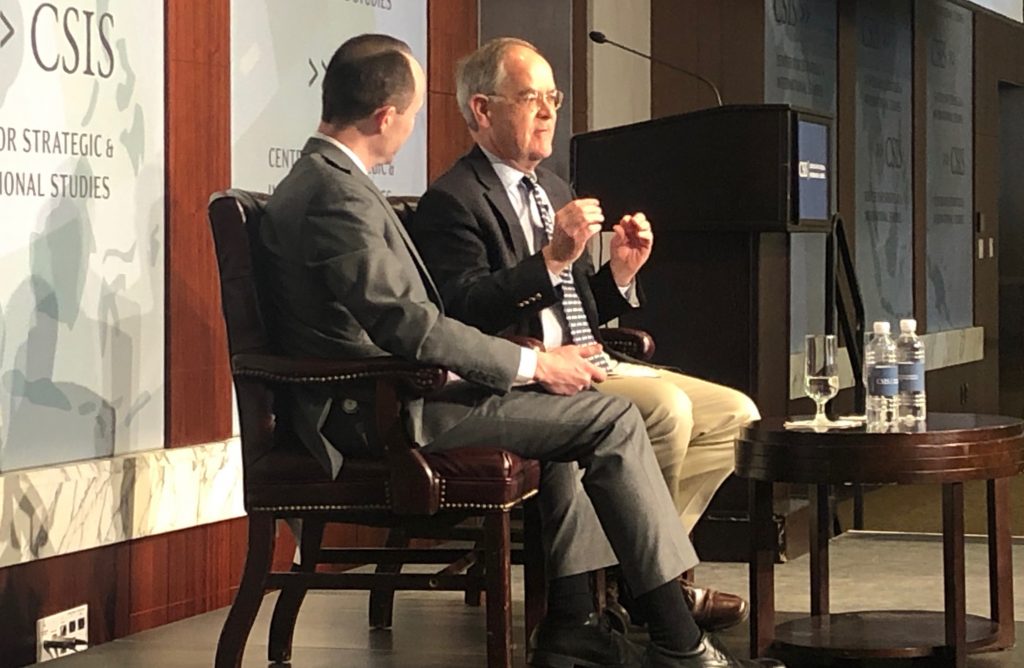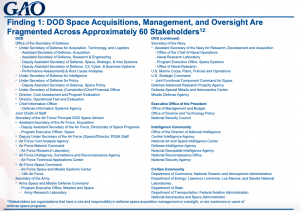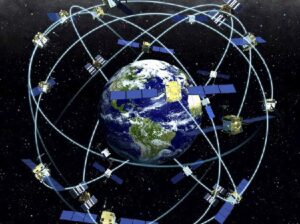
Rep. Jim Cooper (right) at CSIS
WASHINGTON: The Trump Administration and Democrat Rep. Jim Cooper think there is a good shot at getting Space Force legislation through this Congress, but there appear to be yawning gaps in the plan.
What’s the problem? The Government Accountability Office famously outlined the 60 different entities involved in space acquisition a few years ago, noting how convoluted and complex the process was. As far as anyone knows, the new Space Force looks like it will have exactly the same acquisition set up, as the GAO’s head of space and missile defense acquisition, Cristina Chaplain, noted today.
“We had that famous slide of 60 organizations, and I’m not quite sure that’s going away,” Chaplain said at the Center for Strategic and International Studies.
How complicated is the Air Force space acquisition bureaucracy, before you even get to the physics, engineering and manufacturing? Here’s what Chaplain said in a seminal report almost three years ago:
“DOD space leadership responsibilities are fragmented among several organizations. We identified approximately 60 stakeholder organizations involved in space acquisitions. There are eight organizations with space acquisition management responsibilities. While the Air Force has responsibility for most military space acquisitions, the other military services have their own space efforts as well. The NRO collaborates with DOD as it develops space systems for DOD and the IC. Oversight is spread across 11 offices within the Air Force, Office of the Secretary of Defense (OSD), the IC, and OMB. The Secretary of the Air Force, as the newly designated Principal DOD Space Advisor (PDSA), supported by an advisory body called the Defense Space Council, is responsible for promoting a unified approach to space issues, including acquisitions. Lastly, six DOD organizations from the services, U.S. Strategic Command, and the Office of the Joint Chiefs of Staff are involved in setting requirements for defense space programs.”
Got that?
Well, as Chaplain noted today, that structural gobbledygook does not appear to be changing with the creation of the Space Force.
To be fair to Acting Defense Secretary Pat Shanahan, who is pushing through the Space Force because, well, President Trump ordered him to, there are other efforts afoot to improve space acquisition such as the Space Development Agency. Of course, the SDA will only handle a tiny fraction of space acquisition for years to come, because the Air Force’s existing Space and Missile Systems Center does the vast majority of the work.
(Note that Shanahan is now the subject of a Defense Department Inspector General investigation into whether he “allegedly took actions to promote his former employer, Boeing, and disparage its competitors, allegedly in violation of ethics rules,” as DoD IG spokesperson Dwrena Allen put it.)
But Chaplain pointed to a raft of difficulties that still face space and don’t appear likely to be changed much by creation of the Space Force or by Space Command.
“The next few years are going to be the most challenging (emphasis added) for space for a few reasons,” she said, including continuing delays with Raytheon’s OCX, the crucial ground stations for GPS III, and the darkly complex Joint Space Operations Center (JSpOC) Mission System (JMS), which never seems to get better. (Read the 2018 Operational Test and Evaluation report for proof.) Chaplain said OCX will be “almost five years late.”
I contacted Raytheon about OCX and this is what Dave Wajsgras, their president of Intelligence, information, and services said in a statement: “There have been no schedule slips with the GPS OCX program since 2017, and the GPS III launch last December was clear proof of our progress. We will continue to meet all of our commitments, and importantly, we will meet our June 2021 contractual deadline.”
Of course, betwixt and between Chaplain and Wajsgras’ statements there is room for interpretation. Maybe Raytheon’s been on track since 2017, but hasn’t been able to claw back earlier schedule delays, for example.
As my colleague at Space News, Sandra Erwin, reported while I was lollygagging about in Australia, the Air Force decided to upgrade its current GPS ground system because OCX wouldn’t be ready to handle the GPS III satellites: “The Air Force on Dec. 21 announced a $462 million contract award to Lockheed Martin to continue the modernization of the GPS ground control system that the company has been maintaining since 2013. The upgrades will allow the Air Force to operate the GPS 3 constellation with the existing ground system until 2025, Lockheed Martin said in a Jan. 10 news release.”
And there are other structural challenges facing the Space Force. As several people at the CSIS event pointed out, the Air Force says there are about 30,000 space airmen. But the new Space Force will have, Shanahan said today, only about 15,000 to 20,000 personnel. So where are the rest of them going, or is the Air Force playing a shell game with personnel as it tries to minimize the budget impact of creating the new service? Or is OSD lowballing the number to better sell the service as a minimal impact on the defense budget?
On a more upbeat note, Rep. Jim Cooper, chair of the HASC strategic forces subcommittee, said at CSIS today he is optimistic that the Senate will pass legislation this session creating a space force, notwithstanding SASC Chair James Inhofe’s tepid reaction to the idea. He also told the audience at CSIS that he believes there will be a defense budget deal for $733 billion, which he called “a very good number.” Cooper also told reporters he thought the House would pass a mini-omnibus defense spending bill by June, “in record time.” The Senate? Well….
Pass a preemptive CR, deal with inflation and watch the debt limit: 3 tasks for Congress
John Ferrari and Elaine McCusker of AEI argue in this op-ed that Congress needs to act quickly to ensure American national security before getting bogged down in election season.





























